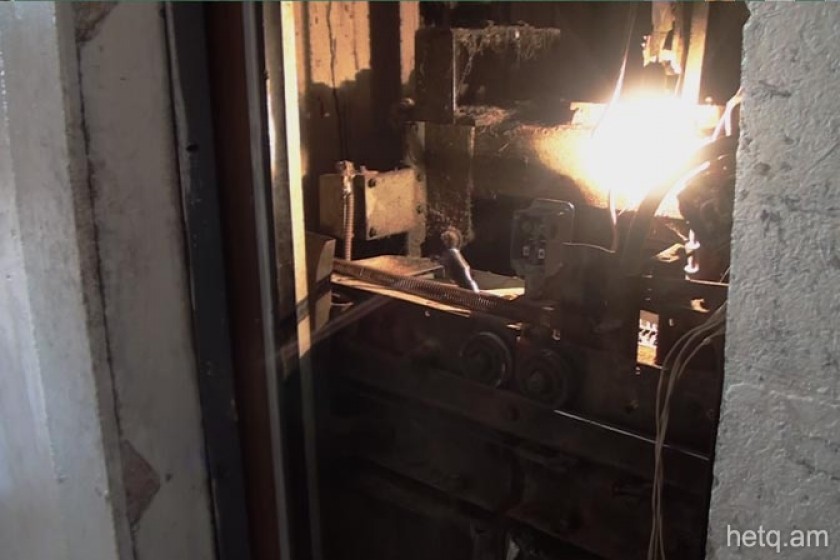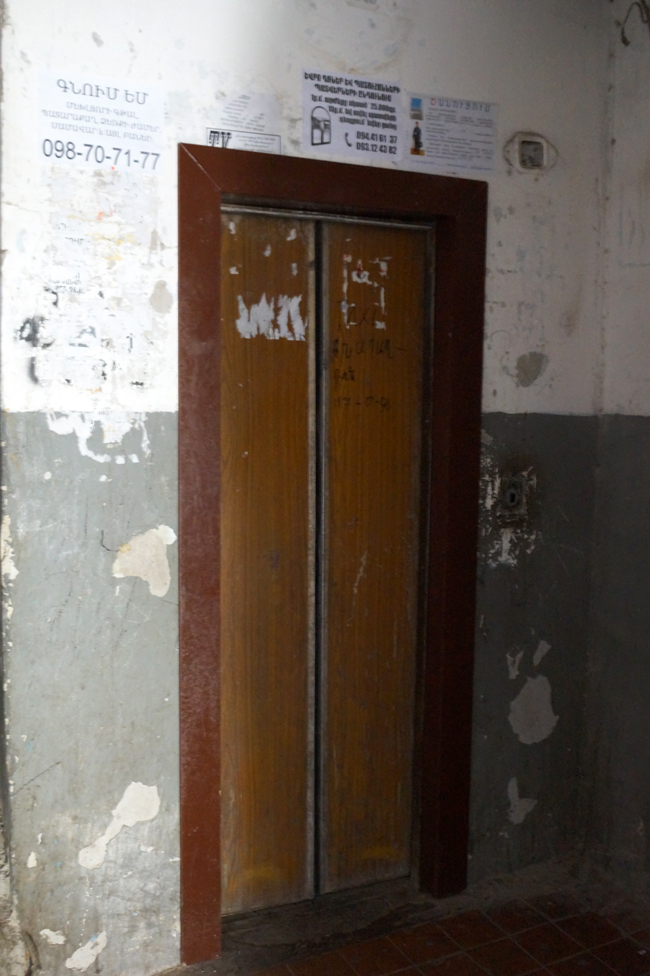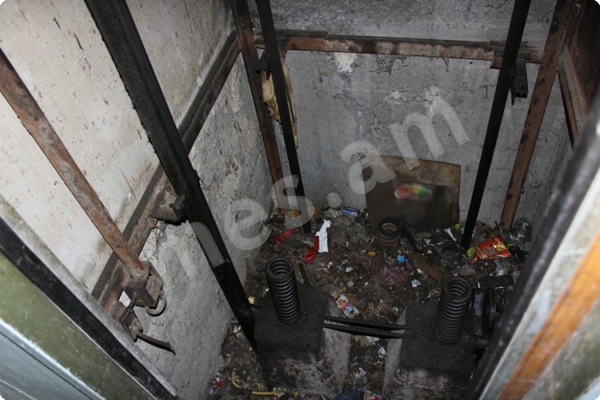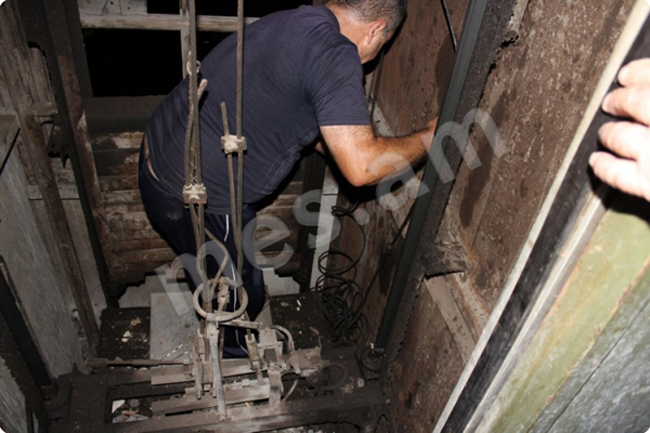
Yerevan’s Deadly Elevators: A Maze of Confusion in Which No One is Held Accountable
The woman’s voice is overwrought when she recounts how a relative was killed in an elevator accident six years ago.
“They fixed it Monday and the accident happened Wednesday.”
So just how shoddy are apartment house elevators in Yerevan?
A few days before going to press an emergency was called in from a house on Vilnius Street on Yerevan’s Nor Nork district – the elevator had stalled with two people inside. The doors were faulty and the power shut down. Residents called emergency services and a team arrived, finally freeing the trapped two.
One of them, Hasmik Hambardzoumyan, said the doors were always on the blink. They fix them but they break down again.
According to the Ministry of Territorial Government and Emergency Affairs (MTGEA), nine elevator emergencies were registered in 2009-2015 in Yerevan. Seven people died as a result. Five died in elevators operating in older buildings and two in new buildings.

36 Vilnius Street
Of the five incidents in older buildings, only two were chalked up to elevator being faulty. One incident happened in 2009 and the second this year. A preliminary investigation into the latter incident, in which one person died, ended today. In the former incident, the court found a number of infringements but no one was criminally charged. The elevator operator was fined 350,000 AMD (US$730).
Negligent Building Management Boards Go Unpunished
On November 25, 2009, Aghavni Kivrikyan and her husband Hovhannes Avetisyan (residents of Yerevan’s 19 Khaghagh Don Street; Entrance #4) returned home by car. Kivrikyan got out of the car and walked to the building entrance to call the elevator to the ground floor. As she got in, the doors immediately closed on her and the elevator started to ascend.
She died when her body hit the structural beams under the first floor. The body was later found inside the elevator.
An investigation revealed that the elevator was faulty; some parts weren’t working. Residents testified in court that the elevator wasn’t working properly days before the deadly accident. A neighbor of the dead woman stated that she had taken the elevator a mere ten minutes before Aghavni Kivrikyan and she barely managed to exit the elevator before the doors quickly shut behind him.

| 19 Khaghagh Don Street (Entrance #4) |
Armenia’s Law on the Management of Multi-Residential Buildings states that elevators are also considered part of the property owned by building owners. The owner of the elevator at19 Khaghagh Don is the Erebouni Administrative District “Urartu” management board. The investigation concluded that “Urartu” failed to comply with elevator safety standards and that the elevator shouldn’t have been operating.
Despite the violations, no one from the “Urartu” management board was prosecuted for criminal negligence. Sevag Simonyan, the board’s president, was never questioned in court.
The elevator’s inspection book was presented to the court. It turns out that the unit was manufactured in 1976 (in Russia) and was put into service in 1983. After 1989, for 20 consecutive years, the elevator was never subjected to the obligatory annual inspection.
According to the law, the elevator operator must see to it that the unit is inspected. “Urartu”, the operator of the deadly elevator, never did so.
The same law regarding the regulation of technical safety standards, also stipulates that it is incumbent on the Ministry of Territorial Government and Emergency Affairs to instruct any management board head negligent in getting its elevators inspected on time to shut down such units. If the board head fails to comply, that person must be fined an amount corresponding to 2,000 times their salary.
Hasmik Hambardzoumyan, the woman who got trapped in the Vilnius Street elevator, said, “ We are grateful that the ministry’s emergency team quickly arrived on the scene.” Sadly, in the case of Aghavni Kivrikyan, they arrived 20 years too late.
 |
 |
19 Khaghagh Don Street
According to the 2005 law, for every year an elevator is not inspected, the management board president must be fined 20 million AMD ($41,732). Thus, for the four years that the elevator which killed Aghavni Kivrikyan hadn’t been inspected (2005-2009), a fine of 80 million should have been imposed.
In 2006, a new state-run agency called the “National Center to Ensure Technical Safety” was created under the jurisdiction of the Ministry of Emergency Affairs. It was tasked with filtering out those elevators in its registry that hadn’t passed any inspection.
Recently, Lousineh Hovhannisyan, head of the Center’s Safety Inspection Division for Elevators, Escalators, Cable Cars and Carousels, called a press conference. When Hetq asked if fines had ever been imposed against negligent operators, Hovhannisyan replied in the affirmative, adding that her division had reviewed the data and had compiled a list of uninspected elevators. The list, she said, had been sent to the agency in charge of taking measures against the negligent elevator operators.
To find out if the MTGEA (Ministry) had ever filed administrative procedures and files against negligent management board presidents, Hetq sent a written request to the ministry asking how many administrative procedures had been filed against elevator operators during 2009-2015, and if so, which of them had paid their fines and gotten their elevators inspected.
The ministry’s response contained no data on the fines imposed or paid by elevator operators. The ministry said it is merely taking measures to register such violations.
 |
 |
| Another broken elevator and emergency services |
The only fine was paid by an electrician. 350,000 AMD and the case is closed
The only person punished was electrician Rouben Baghdasaryan who had entered into a verbal arrangement with residents to inspect their elevator for 3,000 AMD per month. The court found that he was in violation of Article 279 of the RA Criminal Code (Manufacture or sale of goods, or performing work, or providing services which do not meet safety requirements.) and chose to fine him 350,000 AMD.
In court, Hovhannes Avetisyan, husband of Aghavni, did not contest the verdict. He said that the electrician compensated the family for the material and moral damages incurred.
“My son didn’t want to contest the verdict saying, ‘He’s an old man. It’s pitiful. We suffered and it’s past.’ Why should I protest,” said Aghavni’s mother-in-law Anzhela Manoukyan.
During the case, it was noted several times that the electrician was an employee of a company called “Sh and ShSh”. But the court never looked into the company despite the fact that residents of the adjacent entry way testified that they had signed a service contract for their elevator and that they didn’t pay the electrician directly. So how is it that in one case the electrician worked on a contract basis and, in the other, as a side job? None of this was explored by the pre-trial investigative body.
Hetq did some research of its own and revealed that “Sh and ShSh” Ltd. was founded by the Erebouni Neighborhood Council – an agency of the Yerevan municipal government. So, in fact, the Council knew that one of its affiliated employees was doing work on the side.
The company is now being dissolved due to bankruptcy. There are two court cases proving that the company often worked in ways to avoid paying taxes. In 2009, the State Revenue Commission filed a suit to seize 1.374 million in unpaid taxes from the company. The company never paid since another court had already declared it insolvent.
What changes has a death made? The system of unaccountability continues
Anzhela Manoukyan said that she only started taking the elevator last year. “The management board came and said they would fix it. Others now service the elevator,” she said, adding that doesn’t pay the service fee, just her portion of the electricity usage.
The Erebouni Council told Hetq that the Argishti management board now handles the elevators at 19 Khaghagh Ton Street. The building has twelve entrances, each with its own elevator. The board provided the contact information of Rouben Baghdasaryan (the fined electrician) as the service repairman.
In court, and to Hetq, Baghdasaryan claims he isn’t responsible for the accident. “The elevator didn’t come loose. No one knows what happened,” he said.
When asked what company he works for now, Baghdasaryan responded that he officially works for no one. Given a shortage of workers, he’s asked now and then to take a look.
“I have no dealings with residents and haven’t taken any money from them. I just service the elevators. Payment goes through the service company. The company offered me payment and I work accordingly,” said Baghdasaryan.
We should note that Baghdasaryan, as in the past, works for the service company without a contract. This is an important loophole for the company if and when another tragic accident occurs. Baghdasaryan can argue that he worked on the basis of an oral agreement, thus freeing the service company from any liability.
The Erebouni Council says that two years ago the Urartu management board merged with the Argishti board. Despite this claimed merger, according to the State Registry the two boards continue to operate independently of one another. It turns out that last year almost all the buildings managed by Urartu were handed over to Argishti.
19 Khaghagh Ton Street is now managed by Argishti. This board is thus obligated to enter into an elevator service contract with the company referred to by Rouben Baghdasaryan.
To make matters more confusing, Argishti board president Shoushanik Kalantaryan told Hetq that Urartu is still dealing with the elevators at 19 Khaghagh Ton Street.
“Regarding the elevators, Urartu managment board has signed a contract with Yevrolift. This company is servicing the elevators, not the board. For the Argishti board we had a specialist who was servicing the elevators. This hasn’t changed,” Kalantaryan said.
How is it that Urartu signed a contract for the elevators when it neither operates nor owns them?
This is another riddle when it comes to holding the guilty to account. When the next tragic accident occurs, it will come out that the real owner (Argishti) didn’t have a contract with the service provider. The courts will make the same revelation and, just like in the case of Aghavni Kivrikyan, no one will be held accountable.
(To be continued)
 Videos
Videos Photos
Photos




Write a comment